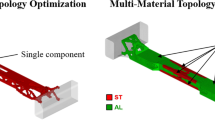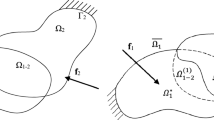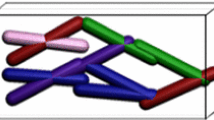Abstract
Present day topology optimization techniques for continuum structures consider the design of single structural components, while most real life engineering design problems involve multiple components or structures. It is therefore necessary to have a methodology that can address the design of multi-component systems and generate designs for the optimal layouts of individual structures and locations for interconnections. The interconnections include supports provided by the ground, joints and rigid connections like rivets, bolts and welds between components. While topology optimization of structures has been extensively researched, relatively little work has been done on optimizing the locations of the interconnections. In this research, a method to model and define domains for the interconnections has been developed. The optimization process redistributes material in the component design domains and locates the connections optimally based on an energy criterion. Some practical design examples are used to illustrate the capability of this method.
Similar content being viewed by others
References
Maxwell, J. (1872) On reciprocal figures, frames, and diagrams of force. Transactions of the Royal Society, Edinburgh, 26, 1
Michell, A. (1904) The limits of economy of material in frame-structure. Phil. Mag, 8, 589–597
Schmit, L. (1960) Structural design of systematic synthesis. In Proceedings of the 2nd ASCE Conf Electr Comp, Pittsburgh, PA, 105–122
Haftka, R.; Grandhi, R. (1986) Structural shape optimization-a survey. Computer Methods in Applied Mechanics and Engineering, 57, 91–106
Bendsøe, M.; Kikuchi, N. (1988) Generating optimal topologies in structural design using a homogenization method. Computer Methods in Applied Mechanics and Engineering, 71, 197–224.
Rozvany, G.; Bendsóe, M.; Kirsch, U. (1995) Layout optimization of structures. Applied Mechanics Review, 48, 2, 41–119
Chirehdast, M.; Gea, H. C.; Kikuchi, N.; Papalambos, P. (1994) Structural configuration examples of an integrated optimal design process. Journal of Mechanical Design, 116, 997–1004
Menassa, R.; DeVries, W. (1991) Optimization methods applied to selecting support positions in fixture design. Journal of Engineering for Industry, 113, 412–418
Yoshimura, M.; Nose, K. (1994) Generation of conceptual design for structural shapes and functional elements of machine systems having no preconceptions concerning the design. Advances in Design Automation, 2, 83–89
Johanson, R.; Papalambros, P.; Kikuchi, N. (1994) Simultaneous topology and material microstructure design. In Advances in Structural Optimization. Proceedings of the Second World Congress on Computational Structures Technology, Athens
Chickermane, H.; Gea, H. C. (1995) Topology optimization of mechanical repairs for aging aircraft. In Computational Mechanics '95, vol. 2, 2171–2176, Springer, Berlin; Proceedings of the International Conference on Computational Engineering Science, July 30–Aug 3, 1995, Hawaii
Gea, H. C. (1996) Topology optimization: a new microstructure based design domain method. Computers and Structures, 61, 4, 781–788
Weng, G. (1984) Some elastic properties of reinforced solids, with special reference to isotropic ones containing isotropic inclusions. International Journal of Engineering Science, 22, 845–856
Mori, T.; Tanaka, K. (1973) Average stress in matrix and average elastic energy of materials with misfitting inclusions. ACTA Metallurgica, 21, 571–574
Eshelby, J. (1957) The determination of the elastic field of an ellipsoidal inclusion and related problems. Proceedings of the Royal Society, A241, 379–396
Chickermane, H.; Gea, H. (1996) A new local function approximation method for structural optimization problems. International Journal of Numerical Methods in Engineering, 39, 829–846
Author information
Authors and Affiliations
Rights and permissions
About this article
Cite this article
Chickermane, H., Gea, H.C. Design of multi-component structural systems for optimal layout topology and joint locations. Engineering with Computers 13, 235–243 (1997). https://doi.org/10.1007/BF01200050
Issue Date:
DOI: https://doi.org/10.1007/BF01200050




